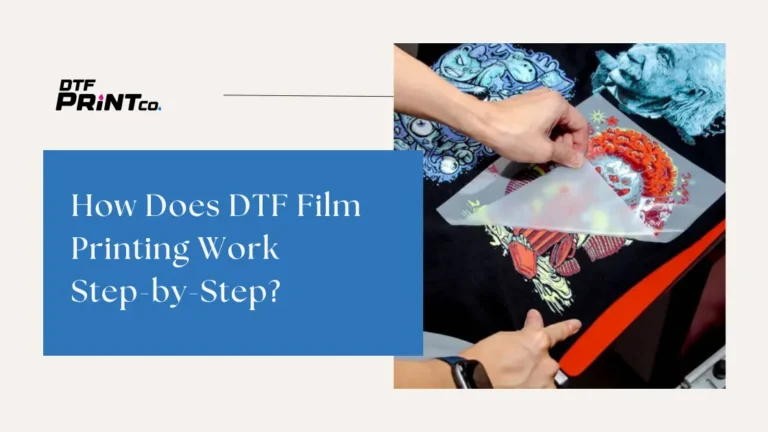
The Difference Between Hot Peel and Cold Peel DTF Film
Direct To Film (DTF) printing is rapidly becoming a popular choice for custom apparel and garment decoration. Unlike traditional screen printing or direct-to-garment (DTG) methods,

Direct-to-film (DTF) printing is quickly becoming one of the most popular methods for transferring designs onto various materials. While it’s often associated with fabric printing, DTF transfers can work wonders on non-fabric materials like wood, plastic, glass, and metal. If you’re curious about how to use DTF transfers on non-fabric materials, you’ve come to the right place. In this article, we’ll walk you through the steps and tips to get stunning prints every time.
DTF stands for Direct-to-Film, a moment’smoit’s printing technique in which designs are printed onto a unique film and then transferred to various surfaces using heat and pressure. Unlike traditional methods like screen printing or vinyl transfers, DTF is versatile and can be used on fabric and non-fabric materials.
The beauty of DTF printing lies in its ability to produce vibrant, long-lasting designs without the need for complex setups or specialized skills. Whether you want to personalize a water bottle, a wooden sign, or a metal keychain, DTF can deliver excellent results.
DTF printing has several advantages that make it an ideal choice for printing on non-fabric materials:
DTF transfers can be applied to many non-fabric surfaces. Some of the most common materials include:
No matter the material, DTF transfers create a smooth, professional-looking finish that will impress.
Now that we understand DTF and why it’s effective for non-fabric materials let’s examine the printing process on these surfaces step-by-step.
The first thing you’ll need is your design. Create your artwork using design software like Adobe Illustrator or Photoshop. Ensure your design is high resolution (at least 300 dpi) to ensure a crisp, clean transfer. Once your design is ready, save it in a format your printer can recognize (such as PNG or TIFF).
It’s to print your design on the DTF transfer film. DTF printers use a particular type of ink (usually pigment-based) that ensures vibrant, long-lasting prints. Load the film into your printer and adjust the print settings for your printing medium. You’ll select the correct media type and resolution to ensure the best results.
One key aspect of DTF printing is applying white ink beneath your design. This layer of white ink helps make your colors pop, especially on non-white surfaces. After printing the design, your printer will automatically apply a layer of white ink on the reverse side of the film.
Once the design and white ink are printed, it’s time to cut the ink. This is done using a heat press or curing oven. Curing ensures that the ink becomes permanent and doesn’t wash. Away. This step is crucial for ensuring that your design adheres well to non-fabric materials.
Now comes the fun part: transferring the design onto the non-fabric material. Heat your heat press to the recommended temperature for your working material (usually around 300°F to 350°F). Place the printed film onto the material and apply even pressure for about 10-15 seconds. Follow each material type’s temperature and pressure settings to avoid damaging the item.
After the transfer is complete, carefully peel off the film. You should now see your design permanently transferred onto the material! Allow the item to cool before handling it, and admire your work. Your print should be vibrant, durable, and professional-looking.
Here are a few tips to ensure the best results when printing on non-fabric materials using DTF:
Some of the most common non-fabric materials that DTF printing works well with include:
Each material requires a slightly different treatment, so adjust your settings accordingly.
DTF transfers work on various materials, but some surfaces may need special treatment. Be sure to test a sample before printing your final design.
How long do DTF prints last on non-fabric materials?
When done correctly, DTF prints are durable and should last years without fading or peeling. For best results, follow the curing instructions.
Can I use DTF printing for small personal projects?
Absolutely! DTF printing is ideal for small businesses, DIY crafters, or anyone looking to create personalized items. The process is easy to learn and can be done with affordable equipment.
Do I need a special printer for DTF transfers?
DTF printing requires a specific printer that can handle pigment inks and DTF film. However, many entry-level printers are available for this purpose.
Is DTF printing safe for beginners?
Yes, DTF printing is beginner-friendly. With some practice and the right tools, anyone can start printing on non-fabric materials with ease.
DTF transfer printing is a versatile and affordable option for creating custom designs on non-fabric materials. Whether printing on Wooyou’red, glass, metal, or plastic, DTF offers a high-quality, long-lasting result that will impress you. You can create professional-grade prints that stand the test of time with suitable materials, equipment, and techniques.
Ready to start your next custom project? Check out our complete The Benefits of DTF Transfer for Small Batch Printing

Direct To Film (DTF) printing is rapidly becoming a popular choice for custom apparel and garment decoration. Unlike traditional screen printing or direct-to-garment (DTG) methods,

If you’ve ever dreamed of creating your own custom shirts, hoodies, or tote bags without spending a fortune or dealing with messy screens, there’s some

If you’re looking to start or grow a custom apparel business, you’ve probably heard about DTF film and sublimation printing. These are two of the

2023 - 2024 © ALL RIGHTS RESERVED